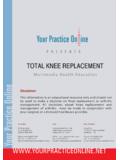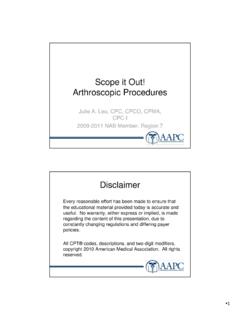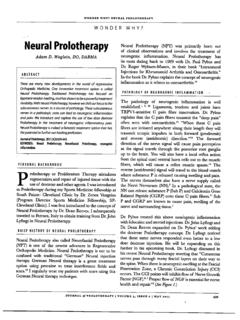Transcription of Your Practice On ine - hips & knees
1 your Practice On ine P R E S E N T S. ACL RECONSTRUCTION. - HAMSTRING METHOD. Multimedia Health Education your Practice Online Disclaimer This movie is an educational resource only and should not be used to make a decision on Anterior Cruciate Ligament (ACL). Reconstruction. All decisions on ACL Reconstruction and management of ACL injury must be made in conjunction with your surgeon or a licensed healthcare provider. Australia USA New Zealand Dr. Prem Lobo Holly Edmonds RN, CLNC Greg Eden Box No. 635 1006 Triple Crown Drive P O Box 17 340 Greenlane Sydney NSW-2001 Indian Trail, NC 28079 Auckland 1130. Phone: +61-2-8205 7549 Office: ( Toll Free) Phone: +64-9-636 1118. Fax: +61-2- 9398 3818 Fax: Fax: +64-9-634 6282. Email: E-mail: E-mail: your Practice On ine ACL RECONSTRUCTION.
2 Multimedia Health Education MULTIMEDIA HEALTH EDUCATION MANUAL. TABLE OF CONTENTS. SECTIONS CONTENT PAGE. 1. Normal Knee a. Bones 4. b. Fibrous Tissue 7. 2. Pathology a. Injury 9. b. Symptoms 10. c. Diagnosis & Treatments 10. 3. ACL Reconstruction a. Surgical Procedure 12. b. Post Operative 15. 4. Conclusion 16. your Practice On ine ACL RECONSTRUCTION. Multimedia Health Education INTRODUCTION. "Doc, I fell and twisted my knee. I heard a pop. It hurt briefly." This could be a ligament tear or rupture. Ligaments are tough, non-stretchable fibers that hold your bones together. But when you injure a ligament, you may feel as though your knees will not allow you to move or even hold you up. The knee, comprised of the femur, tibia, and patella, is a compound joint capable of movement in multiple planes.
3 your Practice Online The articulation of the femur and tibia permits flexion, extension, and a small amount of rotation. A complex array of ligaments provides stability to the knee joint during these movements. Although not specifically part of the knee joint itself, the articulation of the tibia and fibula also allows for a slight degree of movement providing an element of flexibility in response to the actions of muscles attaching to the fibula. your Practice On ine ACL RECONSTRUCTION. Multimedia Health Education Section: 1 NORMAL KNEE. a. Bones Femur The femur (thighbone) is the largest and the strongest bone in the body. It is the weight bearing bone of the thigh. It provides Femur attachment to most of the muscles of the knee. (Refer fig. 1). Condyle (Fig.)
4 1). The two femoral condyles make up for the rounded end of the femur. Its smooth articular surface allows the femur to move easily over the tibial (shinbone) Condyle meniscus. (Refer fig. 2). Tibia The tibia (shinbone), the second largest bone in the body, is the (Fig. 2). weight bearing bone of the leg. The menisci incompletely cover the superior surface of the tibia where it articulates with the femur. The menisci act as shock absorbers, protecting the articular surface of the tibia as well as assisting in rotation of the knee. (Refer fig. 3) Tibia (Fig. 3). your Practice On ine ACL RECONSTRUCTION. Multimedia Health Education Section: 1/cont. NORMAL KNEE. Fibula The fibula, although not a weight bearing bone, provides attachment sites for the Lateral collateral ligaments (LCL) and the biceps femoris tendon.
5 The articulation of the tibia and fibula also allows a slight degree of movement, providing an element of flexibility in response Fibula to the actions of muscles (Fig. 4). attaching to the fibula. (Refer fig. 4). Patella The patella (kneecap), attached to the quadriceps tendon above and the patellar ligament below, rests against the anterior Patella articular surface of the lower end of the femur and protects the knee joint. The patella acts as a fulcrum for the quadriceps by holding the quadriceps tendon (Fig. 5). off the lower end of the femur. (Refer fig. 5). your Practice On ine ACL RECONSTRUCTION. Multimedia Health Education Section: 1/cont. NORMAL KNEE. Menisci The medial and the lateral meniscus are thin C-shaped layers of fibrocartilage, incompletely covering the surface of the tibia where it articulates with the femur.
6 The majority of the meniscus has no blood supply and for that reason, when damaged, the meniscus is unable to undergo the normal healing process that occurs in the rest of the body. In addition, a meniscus begins to deteriorate with age, often developing degenerative tears. Typically, when the meniscus is damaged, the torn pieces begin Menisci to move in an abnormal fashion inside the joint. The menisci act as shock (Fig. 6). absorbers protecting the articular surface of the tibia as well as assisting in rotation of the knee. As secondary stabilizers, the intact menisci interact with the stabilizing function of the ligaments and are most effective when the surrounding ligaments are intact. (Refer fig. 6). your Practice On ine ACL RECONSTRUCTION. Multimedia Health Education Section: 1/cont.
7 NORMAL KNEE. b. Fibrous Tissue Anterior Cruciate Ligament (ACL). The anterior cruciate ligament (ACL) is the major stabilizing ligament of the knee. The ACL is located in the center of the knee joint and runs from the femur Anterior cruciate (thigh bone) to the tibia (shin bone), through the center of the ligament knee. The ACL prevents the femur from sliding backwards on the tibia (or the tibia sliding forwards on the femur). Together with the posterior cruciate ligament (PCL), ACL (Fig. 7). stabilizes the knee in a rotational fashion. Thus, if one of these ligaments is significantly damaged, the knee will be unstable when planting the foot of the injured extremity and pivoting, causing the knee to buckle and give way. (Refer fig. 7). Posterior Cruciate Ligament Posterior cruciate (PCL).
8 Ligament Much less research has been done on the posterior cruciate ligament (PCL) because it is injured far less often than the ACL.(Refer fig. 8). (Fig. 8). your Practice On ine ACL RECONSTRUCTION. Multimedia Health Education Section: 1/cont. NORMAL KNEE. The PCL prevents the femur from moving too far forward over the tibia. The PCL is the knee's basic stabilizer and is almost twice as strong as the ACL. It provides a central axis about which the knee rotates. Collateral Ligaments Collateral Ligaments prevent hyperextension, adduction, and abduction Superficial MCL (Medial Collateral Ligament). connects the medial epicondyle of the femur to the medial condyle of the tibia and resists valgus force. Collateral ligaments Deep MCL (Medial Collateral Ligament). connects the medial epicondyle of the femur with the medial meniscus.
9 LCL (Lateral Collateral (Fig. 9). Ligament) entirely separate from the articular capsule, connects the lateral epicondyle of the femur to the head of the fibula and resists varus force. (Refer fig. 9). your Practice On ine ACL RECONSTRUCTION. Multimedia Health Education Section: 2 PATHOLOGY. a. Injury and Symptoms The major cause of injury to the ACL is sports related. This injury occurs when the knee is forcefully twisted or hyper extended. Usually the tearing of the ACL occurs with a sudden (Fig. 10). directional change with the foot fixed on the ground or when a deceleration force crosses the knee. The ACL can be injured in several ways: Changing direction rapidly (Fig. 11). (Refer fig. 10). Slowing down when running(Refer fig. 11). Landing from a jump (Refer fig.)
10 12). Direct contact, such as in a football tackle. (Refer fig. 13). (Fig. 12). Symptom Many patients recall hearing a loud pop when the ligament tears, and feel the knee buckle. (Fig. 13). your Practice On ine ACL RECONSTRUCTION. Multimedia Health Education Section: 2/cont. PATHOLOGY. There is a rapid onset of swelling within the first two hours, and patients usually complain of a buckling sensation in the knee during twisting movements ( attempting to change direction). The symptoms following a tear of the ACL are variable. Usually there is swelling of the knee within a short time following the injury due to bleeding into the knee joint from torn blood vessels in the ligament. Symptom The instability caused by the torn ligament leads to a feeling of insecurity and giving way of the knee, especially when trying to change direction on the knee.









